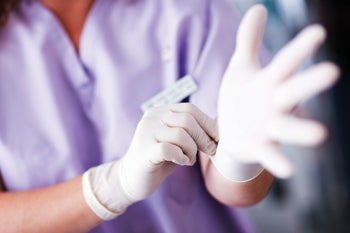Report provides strategies to help prevent HAIs
 |
| Wearing gloves is important for infection prevention. Photo by FUSE/Thinkstock |
The Society for Healthcare Epidemiology of America (SHEA) and the Infectious Diseases Society of America along with the American Hospital Association, the Association for Professionals in Infection Control and the Joint Commission recently teamed up to develop practical strategies to prevent Clostridium difficile and other health care-associated infections (HAIs).
Experts recommend creating a multidisciplinary approach that enlists a range of hospital personnel, including top leaders, clinicians, environmental services (ES) staff, lab personnel, pharmacy technicians and information technology staff.
Deborah Yokoe, M.D., hospital epidemiologist and medical director, infection control, Brigham and Women's Hospital, Boston, and SHEA co-lead author for the compendium, says preventing HAIs takes a team effort because of the difficulties involved.
The collaboration focused on making the infection prevention strategies as practical as possible.
The other objective was to provide a single source of information from among the abundance of guidelines. "One of the major goals of the compendium was to hone the recommendations from the many HAI prevention guidelines that are available to a relatively concise set of documents that hospitals could use as a one-stop shopping guide to prioritize their HAI prevention efforts," she says.
Key strategies for hospitals and other acute care settings to follow include:
- Ensuring environmental decontamination by educating ES staff about proper cleaning of patients' rooms and high-touch surfaces.
- Practicing effective hand hygiene. Hand-hygiene protocols should be measured periodically to ensure compliance.
- Isolating C. difficile patients from the general patient population.
- Conducting surveillance and performance measures.
The report notes that areas that require more research before making a recommendation include required use of gowns and gloves by family members and other visitors, and use of no-touch disinfection technology such as ultraviolet lights and hydrogen peroxide vapors.
Guidelines that prioritize strategies to reduce C. difficile were published in the June issue of Infection Control and Hospital Epidemiology.


